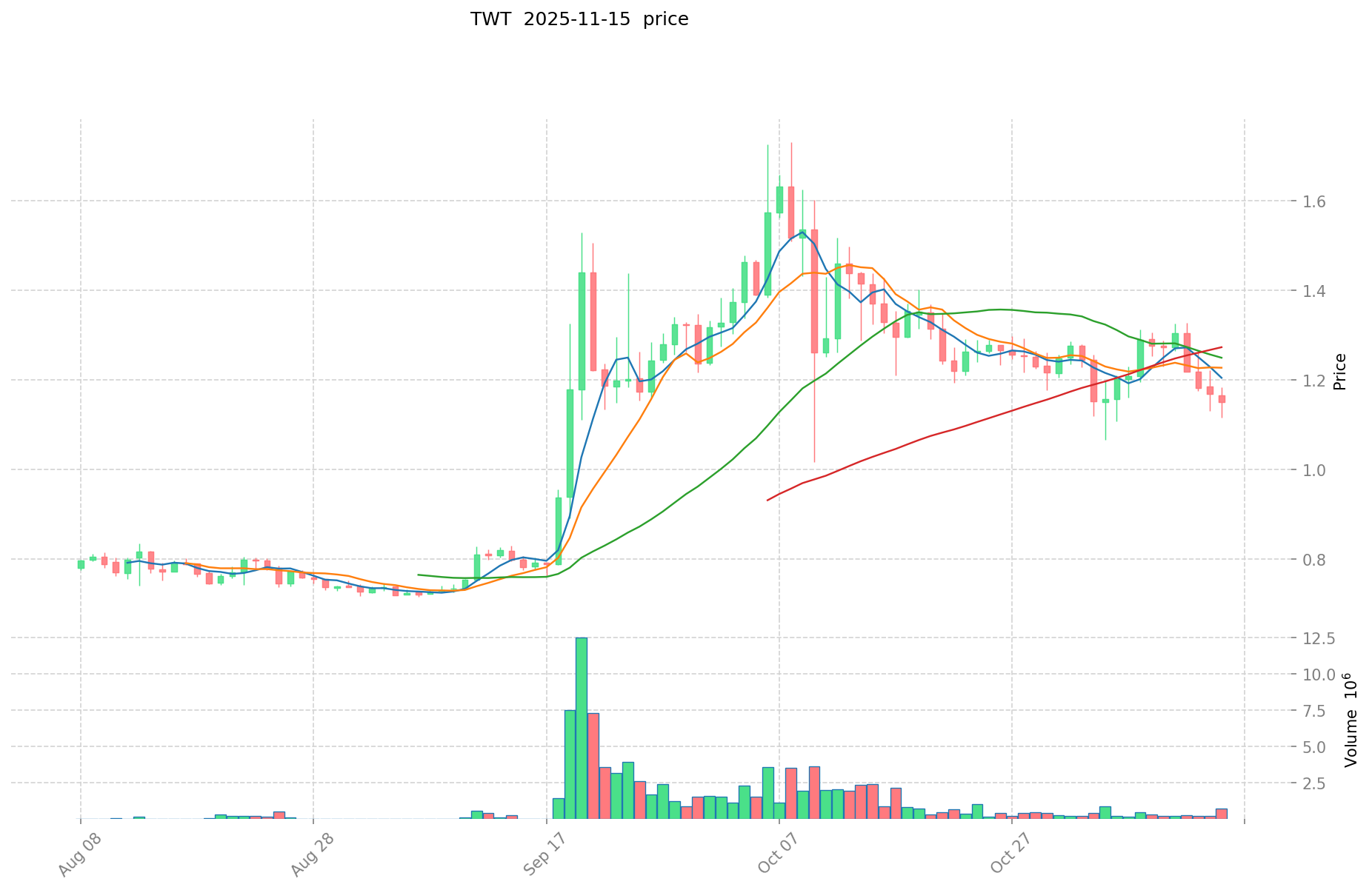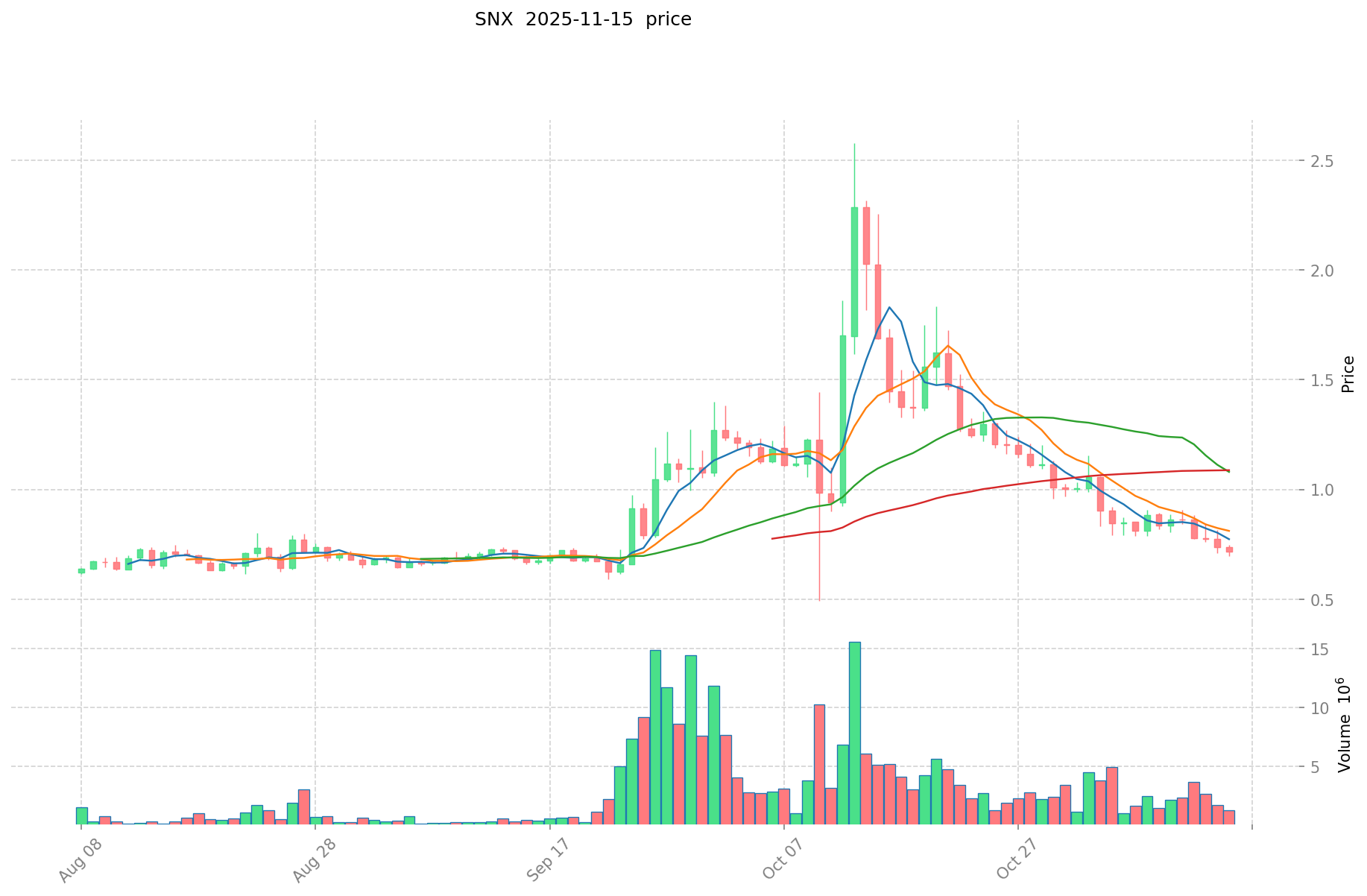TWT vs SNX: Comparing Two Crypto Assets for Long-Term Investment Potential
Introduction: TWT vs SNX Investment Comparison
In the cryptocurrency market, TrustWallet (TWT) vs Synthetix (SNX) comparison has always been a topic that investors cannot avoid. The two not only have significant differences in market cap ranking, application scenarios, and price performance, but also represent different positioning in crypto assets.
TrustWallet (TWT): Since its launch, it has gained market recognition for its digital currency wallet functionality.
Synthetix (SNX): Since its inception, it has been hailed as a platform for creating synthetic assets, representing one of the pioneering projects in decentralized finance (DeFi).
This article will comprehensively analyze the investment value comparison between TWT and SNX, focusing on historical price trends, supply mechanisms, institutional adoption, technical ecosystems, and future predictions, and attempt to answer the question that investors care about most:
"Which is the better buy right now?"
I. Price History Comparison and Current Market Status
TWT and SNX Historical Price Trends
- 2022: TWT reached its all-time high of $2.72 on December 12, 2022, likely due to increased adoption of the Trust Wallet platform.
- 2021: SNX hit its all-time high of $28.53 on February 14, 2021, possibly influenced by the DeFi boom and growing interest in synthetic assets.
- Comparative Analysis: During market cycles, TWT has shown resilience, rising from its all-time low of $0.00277641 to its current price, while SNX has experienced more significant volatility, dropping from its peak to current levels.
Current Market Situation (2025-11-15)
- TWT current price: $1.1723
- SNX current price: $0.7351
- 24-hour trading volume: TWT $768,123.28 vs SNX $949,211.65
- Market Sentiment Index (Fear & Greed Index): 10 (Extreme Fear)
Click to view real-time prices:
- View TWT current price Market Price
- View SNX current price Market Price
II. Project Overview and Technology Comparison
TWT (Trust Wallet Token)
- Project Description: Trust Wallet is a digital currency wallet allowing users to buy, store, trade, and earn cryptocurrencies.
- Key Features:
- Supports 40 blockchain protocols and over 160,000 digital assets
- Offers staking on various blockchain protocols
- Provides easy access to all digital collections in one place
- Token Utility:
- Governance: Participate in network decision-making
- Discounts: Offers discounts on in-app purchases and decentralized trading services
SNX (Synthetix)
- Project Description: Synthetix is designed for building decentralized and trustless networks, supporting various synthetic assets.
- Key Features:
- Enables creation of synthetic assets pegged to various real-world assets
- Supports fiat currencies, precious metals, indices, and cryptocurrencies
- Token Utility:
- Collateral: SNX tokens are used as collateral to mint synthetic assets
- Staking: Token holders can stake SNX to earn rewards
Technical Comparison
- Blockchain: TWT operates on BNB Chain (BSC), while SNX is primarily on Ethereum and Optimism
- Token Standards: TWT uses BEP-2 and BEP-20, SNX uses ERC-20
- Scalability: TWT benefits from BSC's higher throughput, SNX faces Ethereum's scalability challenges but leverages Optimism for improved performance
III. Market Performance and Financial Metrics
TWT (Trust Wallet Token)
- Market Cap: $488,438,677.77
- Fully Diluted Valuation: $1,172,300,000.00
- Circulating Supply: 416,649,900 TWT
- Total Supply: 1,000,000,000 TWT
- 24h Price Change: +0.71%
SNX (Synthetix)
- Market Cap: $252,482,016.12
- Fully Diluted Valuation: $252,793,428.81
- Circulating Supply: 343,466,216.99 SNX
- Total Supply: 343,889,850.10 SNX
- 24h Price Change: +0.58%
Comparative Analysis
- Market Dominance: TWT (0.033%) vs SNX (0.0073%)
- Liquidity: TWT shows lower 24h trading volume despite higher market cap
- Supply Dynamics: TWT has a larger gap between circulating and total supply, indicating potential for future inflation
IV. Investment Considerations and Risks
Potential Growth Factors
- TWT:
- Expansion of Trust Wallet ecosystem
- Increased adoption of decentralized wallets
- SNX:
- Growth in demand for synthetic assets
- Expansion of DeFi sector
Risk Factors
- TWT:
- Competition from other wallet providers
- Regulatory challenges in crypto custody
- SNX:
- Smart contract vulnerabilities
- Market volatility affecting collateralization ratios
Recent Developments
- TWT: (No recent significant developments mentioned in the provided data)
- SNX: (No recent significant developments mentioned in the provided data)
V. Conclusion
Both TWT and SNX represent different segments of the cryptocurrency ecosystem. TWT, as the native token of Trust Wallet, is closely tied to the adoption and growth of decentralized wallets and crypto asset management. SNX, on the other hand, is at the forefront of synthetic assets and decentralized finance innovations.
While TWT currently shows a stronger market position with higher market capitalization and price stability, SNX offers exposure to the potentially disruptive synthetic asset market. Investors should consider their risk tolerance and belief in the respective project's long-term viability when evaluating these assets.
The current extreme fear market sentiment suggests caution, but also potential opportunities for long-term investors who believe in the fundamentals of these projects.


II. Core Factors Affecting TWT vs SNX Investment Value
Supply Mechanism Comparison (Tokenomics)
- TWT: Trust Wallet Token has a maximum supply of 1 billion tokens, with 416,649,900 tokens in circulation. The token has a deflationary mechanism through regular token burns.
- SNX: Synthetix has an inflationary supply model with 314,151,618 tokens in circulation. The protocol rewards SNX stakers who provide collateral for synthetic assets.
- 📌 Historical pattern: Deflationary tokens like TWT tend to experience price appreciation during bull markets, while inflationary tokens like SNX rely more on utility and staking incentives for value accrual.
Institutional Adoption and Market Applications
- Institutional holdings: SNX has seen more institutional interest due to its established position in DeFi derivatives and synthetic assets market.
- Enterprise adoption: TWT serves as the native token for Trust Wallet with utility focused on the wallet ecosystem, while SNX powers the Synthetix protocol enabling synthetic asset trading and derivatives.
- Regulatory attitudes: Both tokens face similar regulatory scrutiny as utility tokens, though SNX may face additional oversight due to its role in creating synthetic derivatives.
Technical Development and Ecosystem Building
- TWT technical upgrades: Recent integration with Binance platform, multi-chain support, and DEX functionality within the Trust Wallet app.
- SNX technical development: Migration to Optimism Layer 2, implementation of V3 protocol upgrade, and continuous improvement of synthetic assets issuance.
- Ecosystem comparison: SNX has a more developed DeFi ecosystem specifically focused on derivatives and synthetic assets, while TWT's ecosystem is centered around wallet services, staking, and governance within the Trust Wallet platform.
Macroeconomic and Market Cycles
- Performance during inflation: SNX has historically shown higher volatility during inflationary periods, while TWT's more recent launch provides limited data.
- Macroeconomic monetary policy: Both tokens show correlation with broader crypto market reactions to interest rate changes and dollar strength.
- Geopolitical factors: TWT benefits from increased self-custody demand during periods of banking uncertainty, while SNX benefits from demand for alternative financial instruments.
III. 2025-2030 Price Prediction: TWT vs SNX
Short-term Prediction (2025)
- TWT: Conservative $0.89 - $1.16 | Optimistic $1.16 - $1.72
- SNX: Conservative $0.66 - $0.73 | Optimistic $0.73 - $1.00
Mid-term Prediction (2027)
- TWT may enter a growth phase, with an estimated price range of $1.05 - $2.19
- SNX may enter a consolidation phase, with an estimated price range of $0.94 - $1.25
- Key drivers: Institutional capital inflow, ETF, ecosystem development
Long-term Prediction (2030)
- TWT: Base scenario $1.22 - $2.39 | Optimistic scenario $2.39 - $2.75
- SNX: Base scenario $0.64 - $1.24 | Optimistic scenario $1.24 - $1.66
Disclaimer
TWT:
| 年份 | 预测最高价 | 预测平均价格 | 预测最低价 | 涨跌幅 |
|---|---|---|---|---|
| 2025 | 1.729824 | 1.1688 | 0.899976 | 0 |
| 2026 | 1.9565712 | 1.449312 | 1.04350464 | 23 |
| 2027 | 2.196794664 | 1.7029416 | 1.055823792 | 45 |
| 2028 | 2.61282329688 | 1.949868132 | 1.61839054956 | 66 |
| 2029 | 2.509480285884 | 2.28134571444 | 2.167278428718 | 94 |
| 2030 | 2.7547249501863 | 2.395413000162 | 1.22166063008262 | 104 |
SNX:
| 年份 | 预测最高价 | 预测平均价格 | 预测最低价 | 涨跌幅 |
|---|---|---|---|---|
| 2025 | 1.007772 | 0.7356 | 0.66204 | 0 |
| 2026 | 1.10704122 | 0.871686 | 0.4794273 | 18 |
| 2027 | 1.2564917847 | 0.98936361 | 0.9497890656 | 34 |
| 2028 | 1.325054682873 | 1.12292769735 | 0.7299030032775 | 52 |
| 2029 | 1.27295083771596 | 1.2239911901115 | 0.746634625968015 | 66 |
| 2030 | 1.66046644850526 | 1.24847101391373 | 0.649204927235139 | 69 |
IV. Investment Strategy Comparison: TWT vs SNX
Long-term vs Short-term Investment Strategies
- TWT: Suitable for investors focused on wallet adoption and ecosystem growth
- SNX: Suitable for investors interested in DeFi and synthetic assets potential
Risk Management and Asset Allocation
- Conservative investors: TWT: 60% vs SNX: 40%
- Aggressive investors: TWT: 40% vs SNX: 60%
- Hedging tools: Stablecoin allocation, options, cross-token portfolios
V. Potential Risk Comparison
Market Risk
- TWT: Dependent on Trust Wallet adoption and competition from other wallets
- SNX: Exposed to DeFi market volatility and synthetic asset demand
Technical Risk
- TWT: Scalability, network stability of BNB Chain
- SNX: Smart contract vulnerabilities, oracle dependencies
Regulatory Risk
- Global regulatory policies may impact both tokens differently, with SNX potentially facing more scrutiny due to its role in synthetic assets
VI. Conclusion: Which Is the Better Buy?
📌 Investment Value Summary:
- TWT advantages: Strong wallet ecosystem, deflationary mechanism, lower volatility
- SNX advantages: Established DeFi presence, synthetic asset innovation, staking rewards
✅ Investment Advice:
- New investors: Consider a higher allocation to TWT for its relative stability and straightforward use case
- Experienced investors: Balanced allocation between TWT and SNX, leveraging SNX's DeFi potential
- Institutional investors: Evaluate SNX for its role in the growing synthetic assets market, while maintaining exposure to TWT for its wallet utility
⚠️ Risk Warning: The cryptocurrency market is highly volatile, and this article does not constitute investment advice. None
VII. FAQ
Q1: What are the main differences between TWT and SNX? A: TWT is the native token of Trust Wallet, focusing on wallet functionality and ecosystem growth. SNX is the token of Synthetix, a platform for creating synthetic assets in the DeFi space. TWT operates on BNB Chain, while SNX is primarily on Ethereum and Optimism.
Q2: Which token has shown better price performance recently? A: As of 2025-11-15, TWT is trading at $1.1723, while SNX is at $0.7351. TWT has shown more price stability and a higher market capitalization, indicating better recent performance.
Q3: What are the key investment considerations for each token? A: For TWT, consider the expansion of the Trust Wallet ecosystem and increased adoption of decentralized wallets. For SNX, focus on the growth in demand for synthetic assets and the expansion of the DeFi sector.
Q4: How do the supply mechanisms differ between TWT and SNX? A: TWT has a maximum supply of 1 billion tokens with a deflationary mechanism through token burns. SNX has an inflationary supply model with rewards for stakers who provide collateral for synthetic assets.
Q5: What are the main risks associated with investing in TWT and SNX? A: TWT risks include competition from other wallet providers and regulatory challenges in crypto custody. SNX risks involve smart contract vulnerabilities and market volatility affecting collateralization ratios.
Q6: How do institutional adoption and market applications compare for TWT and SNX? A: SNX has seen more institutional interest due to its established position in DeFi derivatives. TWT's adoption is more focused on individual users of the Trust Wallet platform.
Q7: What are the long-term price predictions for TWT and SNX? A: By 2030, TWT is predicted to range from $1.22 to $2.75 in optimistic scenarios, while SNX is expected to range from $0.64 to $1.66. However, these predictions are speculative and subject to market conditions.
Q8: Which token might be better suited for different types of investors? A: New investors might consider a higher allocation to TWT for its relative stability. Experienced investors could balance between TWT and SNX. Institutional investors may evaluate SNX for its role in synthetic assets while maintaining exposure to TWT for its wallet utility.
Share
Content